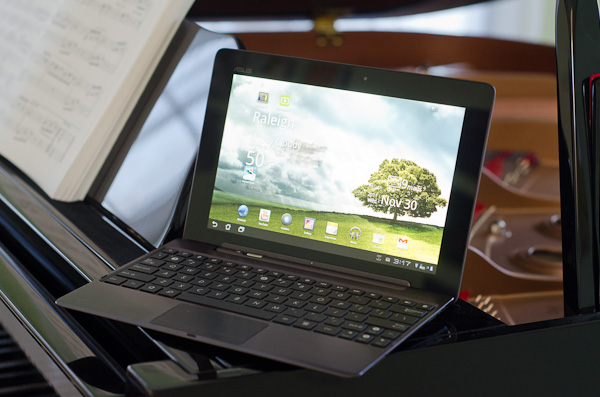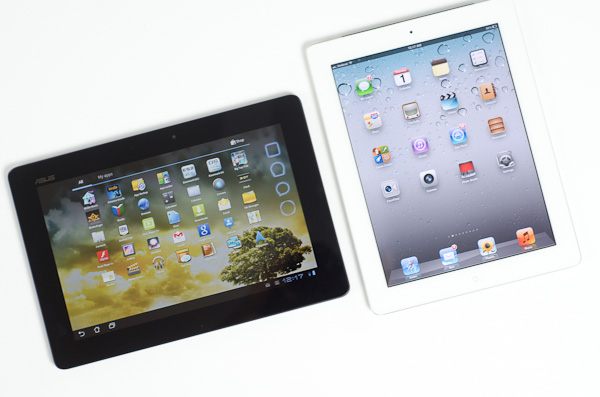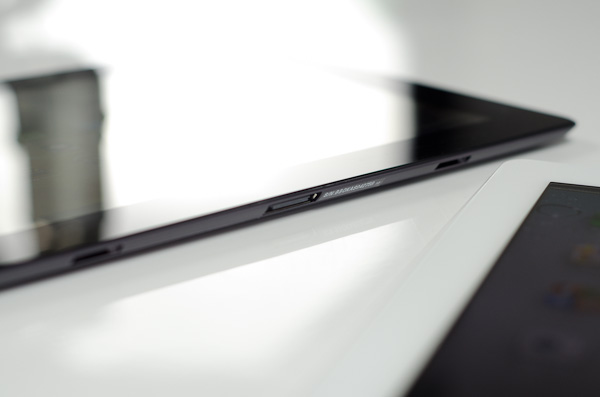ASUS Eee Pad Transformer Prime & NVIDIA Tegra 3 Review
by Anand Lal Shimpi on December 1, 2011 1:00 AM ESTGoing from making good motherboards to going head to head with Samsung for Google's affection is a pretty big step for ASUS, but it's one that the company has taken and done very well with. None of its peers have made the same transition, especially not while continuing to thrive in their existing businesses. I don't think anyone can say that ASUS' motherboards have suffered over the past several years as the company has transitioned, much like Apple, into the world of being a mobile computer manufacturer.
ASUS' first Android tablet was a knock out of the park. The original Eee Pad Transformer gave us a glimpse of the future with its keyboard dock while delivering a good Honeycomb experience for $100 less than the competition. As many sacrifices as ASUS had to make to reach its price point, the original Eee Pad remains one of the best Honeycomb tablets on the market. But the show must go on and simply being the cheapest on the block doesn't work anymore, particularly with companies like Amazon redefining what cheap means. It was time for a new flagship and today we have that tablet:
Priced at $499 the Eee Pad Transformer Prime will be available in North America during the week of 12/19.
| Tablet Specification Comparison | ||||||
| ASUS Eee Pad Transformer | ASUS Eee Pad Transformer Prime | Apple iPad 2 | Samsung Galaxy Tab 10.1 | |||
| Dimensions | 271mm x 175mm x 12.95mm | 263 x 180.8 x 8.3mm | 241.2 x 185.7 x 8.8mm | 256.6 x 172.9 x 8.6mm | ||
| Display | 10.1-inch 1280 x 800 | 10.1-inch 1280 x 800 Super IPS+ | 9.7-inch 1024 x 768 IPS | 10.1-inch 1280 x 800 PLS | ||
| Weight | 675g | 586g | 601g | 565g | ||
| Processor | 1GHz NVIDIA Tegra 2 (2 x Cortex A9) | 1.3GHz NVIDIA Tegra 3 (4 x Cortex A9) | 1GHz Apple A5 (2 x Cortex A9) | 1GHz NVIDIA Tegra 2 (2 x Cortex A9) | ||
| Memory | 1GB | 1GB | 512MB | 1GB | ||
| Storage | 16GB + microSD card | 32GB/64GB + microSD slot | 16GB | 16GB | ||
| Pricing | $399 | $499/$599 | $499 | $499 | ||
Whereas Motorola was first out of the gate with a Tegra 2 based Honeycomb tablet, ASUS is done with playing second fiddle. ASUS is NVIDIA's first and only launch partner for its new quad-core Tegra 3 SoC. The Google OS of choice is still Honeycomb, although I hear the Eee Pad Transformer Prime also happens to be Google's development and validation vehicle for Ice Cream Sandwich on Tegra 3.
The Prime is everything the original Eee Pad Transformer was missing. It's thinner than an iPad 2 or Galaxy Tab and built out of aluminum and glass. Other than minor details like the buttons and connectors, your hands never touch plastic when using the Transformer Prime. Even those plastic buttons look and feel great. The tablet is just beautiful. It echoes the design language of ASUS' Zenbook, but without the disappointment in the panel department. ASUS' latest tablet actually has the best display of any tablet we've reviewed, including those made by Apple and Samsung (more on this later).
The usual suspects are carefully placed around the perimeter of the Transformer Prime. Held in landscape mode the power/lock button is at the top left corner, with the volume rocker perpendicular to and just below it on the left side. Also along the left side is a micro HDMI output for display cloning and a microSD card slot. A standard 1/8" headset jack finds itself on the right side of the tablet, and ASUS' standard dock connector is bottom center. The original Eee Pad had two speaker grills, while the Prime has a single, larger speaker on the back of the device. Audio output is surprisingly full but the tablet doesn't get loud enough to overpower a noisy environment.
ASUS went a little crazy with the rubber stoppers all over the Prime. The dock connector and its two mechanical retention/secure points are plugged with these things, as is the USB port on the optional transformer dock.
Just like last time, the Eee Pad Transformer Prime can be mated to an optional keyboard dock for an extra $149. The dock adds a QWERTY keyboard, trackpad, an SD card reader, USB port and comes with its own 22Wh battery. The dock's battery not only powers itself but it can charge the Prime's battery, almost doubling battery life.
We'll spend the next several pages going through every detail of the new Eee Pad Transformer Prime as well as NVIDIA's Tegra 3 SoC, but on the surface, ASUS has built a formidable tablet. How does it fare under closer scrutiny? Very well it turns out...
A Lesson in How Not to Launch a Product
Of all of the things ASUS has learned from running the PC side of its business it seems that the proper way to launch a brand new platform didn't translate over to its tablet business. I received the Eee Pad Transformer Prime 39 hours ago and the NDA lifted just now. While this is not atypical for many mobile launches, ASUS should know better.
To do a thorough review of any product the minimum time we need to adequately integrate that product into our daily routine and come away with a deep understanding of the product is at least a week. I say that's the minimum amount of time because if you give us more, then we can do even better analysis and spend even more time bug hunting. Most of the players in the mobile space don't really get this, and as a result they are complicit in the disappointing amount of analysis that's done on their hardware. This will change as time goes on, but I honestly expected more from ASUS.
My WiFi is Broken
What's one of the biggest risks when you give reviewers only 39 hours to review a product? If something is wrong with the review sample, there's hardly any time to fix it. This time I drew the short straw and my Transformer Prime review sample arrived with highly questionable WiFi performance. Both range and performance were impacted by whatever plagued my sample. I got less range and much lower performance than the original Eee Pad Transformer regardless of location or wireless access point. How bad? My Prime had difficulty sustaining more than 2Mbps over WiFi. ASUS and NVIDIA both sent me proof that there wasn't something wrong with other samples, and from their data it looks like the WiFi stack in the Prime is at least comparable to the original Transformer. The problem may just be limited to my unit, although I tend to believe that if something goes wrong once, it's bound to go wrong more than once.
Based on the fact that wireless performance improves when docked and upstream speeds are almost normal, if I had to guess I'd say that the receive antenna is either not fully connected or somehow impaired from doing its normal duty. I should have a replacement unit in by tomorrow, but unfortunately that means you won't see any WiFi dependent results here.
ASUS chose Broadcom's BCM4329 for WiFi/Bluetooth duty. Although the controller supports both 2.4GHz and 5GHz operation, the Prime is limited to work on 2.4GHz networks. The rest of the design is pretty standard - you get a single spatial stream at a maximum of 72Mbps. Real world performance, if ASUS/NVIDIA's numbers are to be believed, should top out somewhere in the upper 30Mbps area.
Update: ASUS got us a fixed unit, be sure to check out our follow-up here.




















204 Comments
View All Comments
ATOmega - Tuesday, December 6, 2011 - link
Exactly my reasoning, and it's easy enough to see that the Transformer Prime boasts better features like GPS, camera and display.After having owned an iPad2, there must be a reason why I want this thing. And it's for all the things Apple decided to fleece me on so that they could jack up their margins.
I never liked Apple in the first place, but it's obvious they don't want to truly compete with the Android OS.
sigmatau - Thursday, December 1, 2011 - link
I was really hoping Nvidia would have something special with kal-el. This is pretty horrible when compared to hardware that has been available for about a year.It seems that the Nvidia-equiped tablets should be targeted at a much lower price point. They definetly should not be in the top tier tablets. I can see them selling at $300 or less.
UpSpin - Thursday, December 1, 2011 - link
Don't forget the display brightness. I don't think that the processor makes such a huge difference in power consumption, but the display on the Prime is much much brighter than the display of the iPad, and this will consume a huge amount of power. It's also brighter than the display of the first gen transformer, and the prime has a quad core and it gets the same or higher battery life than the first gen, I think that's really a big improvement.And if you want to use a tablet on the go, outside the house, you really need the brightest display possible. And as you can see in the picture, the difference between the sunlight visibility of the iPad and Prime is like day and night. Therefore I at least, sacrifice the 3 hours less battery life.
name99 - Thursday, December 1, 2011 - link
The display surely only uses more power if you drive it at a brighter level?And a well-designed tablet should have a light sensor, and should do a good job of auto-calibrating the brightness to the environment, so that most of the time it is NOT running the screen in bright mode. After all, that's what we expect regarding the core --- we throttle CPU when it's not needed. So, sorry, I don't think this is an acceptable answer.
I continue to state my original thesis --- I suspect that DRAM power is substantially more important than most people believe, and that one of Apple's advantages is that they ship iOS devices with minimal DRAM. This is obviously a hassle for developers, and even for some power users, but that's the tradeoff one has to make.
(Also what's the story with Android and VM? iOS does NOT do any "write" swapping --- code is paged in, but data is not paged out, and I expect that this is a power issue, nothing else --- Apple doesn't want the power hit of swapping.
I thought Android was like this --- did not write pages --- but I have read stuff recently that said no, it is now using standard desktop type VM, which is likely also a power sink.)
metafor - Thursday, December 1, 2011 - link
nVidia's solution is actually much more sophisticated than that. It's similar to a method Intel started using a ways back for laptops.It's not just auto-dimming the entire screen; it's auto-dimming every pixel individually. There is fine-grain control over the LED backlight of the display. Areas in each frame that contains black will now not only have the LCD crystal for that pixel in a "block" mode, but it will also have the backlight for that specific pixel dim.
This actually produces benefits other than just battery life; one of the biggest problems with LCD's is that blacks aren't really black because the crystal isn't able to block 100% of the backlight.
By dimming the backlight, the parts of an image that is supposed to be black will be closer to true black. This improves contrast and provides for more accurate pictures.
UpSpin - Friday, December 2, 2011 - link
how shall this work if the backlight is created by an LED array at the edge, which almost all smaller (<20") displays are. So with an edge lit backlight you can't reduce the LED brightness block wise.This is different if the used panel has a full array of LEDs, which is expensive, more power consuming and thicker, so a no go on a mobile device that thin. And neither Intel nor Nvidia have impact on this, because this requires a different panel.
TechAnandUser - Friday, December 2, 2011 - link
BenchMarking App's are not yet optimized. So please wait !!fteoath64 - Friday, December 2, 2011 - link
Why would you want a Win8 tablet ?. Its slow, heavy, short battery-life and probably cost 50% more!.You are better off with a mid-range slim laptop which you probably have. So unless you grab one of these or already have an ipad, you have no idea what a tablet can do for you.eddman - Friday, December 2, 2011 - link
You might have a time machine then, cause right now there are no win 8 tablets, let alone ARM based ones.tipoo - Thursday, December 15, 2011 - link
"Its slow, heavy, short battery-life and probably cost 50% more"Citation needed, citation needed, citation needed, and citation needed respectively. None of us have tested finalized W8 table hardware yet, unless you are from the future.